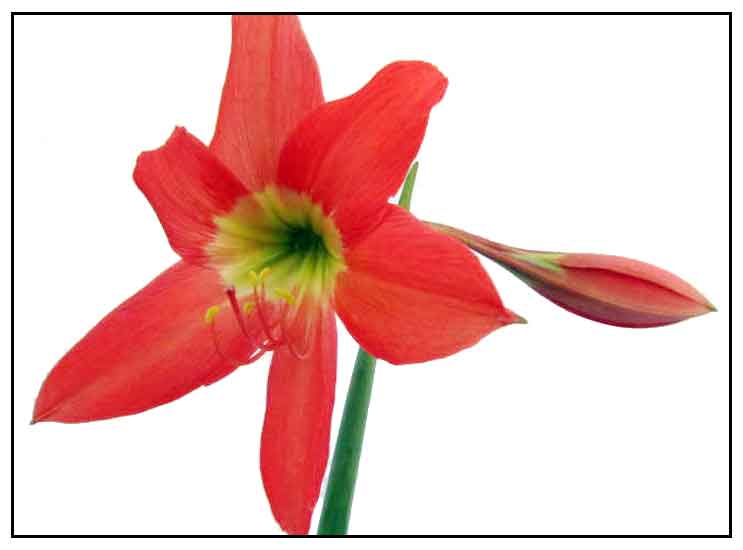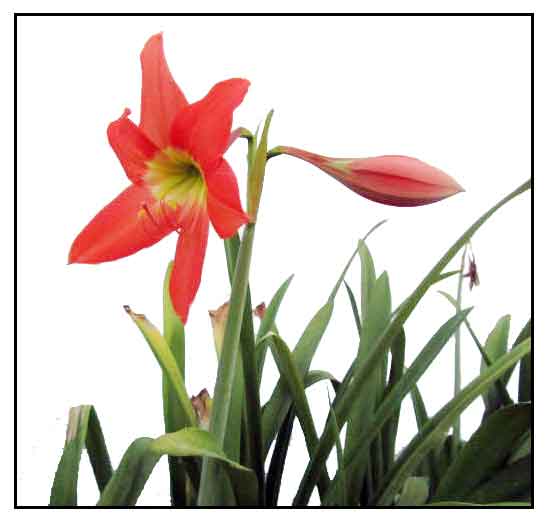 Gen info Gen info
- Hippeastrum is a genus of about 90 species, and over 600 hybrids and cultivars, of perennial, herbaceous and bulbous plants, native to tropical and subtropical regions of the Americas.
- The taxonomy is complicated and the common names are confusing. It is
neither a lily nor a species of Amaryllis.
- Etymology: The name Hippeastrum was first given to the genus by Herbert, derived from Greek words hippeus meaning 'knight's star' and astron meaning 'star'. (19)
Botany
Orange lirio is a bulbous perennial with runners or stolons. Leaves are fleshy green, sword like, 25 to 40 centimeters long, 3 centimeters wide, strap-shaped, narrowed at the tip, developing fully as the flowers wilt. Stem arising from the bulb is cylindrical, hollow, 30 to 40 centimeters long, the tip bearing 2 to 4 stalked, showy, more or less nodding, red or orange colored flowers. Flowers are trumpet-shaped, 8 to 10 centimeters in diameter, the tube about 2.5 centimeters long, and the 6 segments 10 to 12 centimeters long. The fruit is a roundish capsule.
There are several cultivated forms, including a hybrid with dark red flowers with a white stripe running along the center of each segment.
Distribution
- Introduced, probably during Spanish colonial times.
-
Cultivated, not naturalized.
-
Planted in towns
and cities in the Philippines.
- Native to South America: Bolivia, Brazil Northeast, Brazil Southeast, Brazil West-Central, Colombia, Ecuador, French Guiana, Guyana, Peru, Suriname, Venezuela. (5)

Constituents
- Study isolated an alkaloid, 3-O-acetyl-narcissidine.
- Phytochemical screening of various extracts of bulbs yielded alkaloids, carbohydrates, flavonoids, tannins, saponins, terpenoids, proteins and amino acids. The chloroform extract showed the highest amount of phenolics while the ethyl acetate extract yielded the highest amount of flavonoid. (see study below) (4)
- GC-MS analysis of methanolic extract of bulbs and fractions yielded 11 alkaloids: 9-O-demethyllycoramine (1), lycoramine (2), galantamine (3), assoanine (4), kirkine (5), pancratinine (6), 8-demethylmaritidine (7), 11-hydroxyvittatine (8), pseudolicorine (9), 2α-hydroxyhomolycorine (10) and lycorine (11). Four were isolated and identified from the class of isoquinoline alkaloids. (6)
- Ethanolic extract of bulb revealed presence of alkaloids, glycosides, phenolics, flavonoids, terpenoids, carbohydrates, mucilage, starch, tannins, steroids, saponins, proteins, and amino acids. (see study below) (14)
- Study of ethyl acetate fraction of H. puniceum isolated a glycosylated derivative narciclasine-4-O-ß-D-xylopyranoside. (see study below) (15)
 Properties Properties
- Considered antispasmodic, emetic, purgative.
- Studies have suggested antioxidant, anti-inflammatory, neuroprotective, acetylcholinesterase inhibitory properties.
Toxicity
• Contains alkaloids with reported toxicity, especially to cats. Cats are prone to toxicity because of some of the liver enzymes needed to break down toxins. Bulbs are considered the most poisonous part of the plant.
Toxicity is attributed to phenanthridine alkaloid derivatives i.e., lycorine, crinidine, clivacetine clivorine, cliviasine and clividine. Manifestations of poisoning may include gastrointestinal (vomiting, salivation, diarrhea, abdominal pain), convulsions, cardiac arrhythmias, low blood pressure and respiratory depression. (7) (8)
Parts
used
Flowers, bulbs, roots.
Uses
Folkloric
- In Oriental Mindoro, the Hanunuo Mangyan use infusion of plant parts for treatment of head lice: infusion applied directly to the head and covered with a towel for one minute before rinsing. (13)
- Used for stomachaches.
- In French Guiana, flower infusion is considered antispasmodic; locally used for whooping cough. In NW Guyana,
root used to treat asthma, biliousness, as laxative and to induce vomiting. (2)
- In India fresh bulbs traditionally used for healing wounds, tumors, and piles.
- In Jamaica, bulb is used to make plaster with bread or Eryngium foetidum for use on swelling and sores. Also used for abscesses and ulcers. (3)
Studies
• Bioactive Alkaloid / Antifeedant / Plant Protective: Study
isolated a bioactive alkaloid, 3-O-acetyl-narcissidine, which showed antifeedant activity against the polyphagous insect Spodoptera littoralis. The compound also inhibited root growth, root development, and germination of several weeds. Results suggest a plant protective role for H. puniceum alkaloids. (1)
• Phytochemical Examination of Bulbs: Microscopic examination of bulbs showed starch grains, mucilage cells and xylem fibers. Phytochemical screening of various extracts yielded alkaloids, carbohydrates, flavonoids, tannins, saponins, terpenoids, proteins and amino acids. A chloroform extract showed the highest phenolic content. (4)
• Antioxidant / Anti-Inflammatory / Bulbs: Study evaluated an aqueous extract of bulbs of H. puniceum for anti-inflammatory activity using protein denaturation and proteinase inhibition methods and antioxidant activity by iron chelating and total antioxidant assay. Results showed antioxidant and anti-inflammatory potential attributed to flavonoids and phenolics. (9)
• Neuroprotective / Acetylcholinesterase Inhibitory Activity: Study evaluated alkaloidal fractions of five Amaryllidaceae species for neuroprotective activity and acetylcholinesterase inhibitory activity. Hippeastrum puniceum showed AChE enzyme inhibition of 53.95 ± 1.20% at 28.7 µg/mL and IC50 of 25.73 ± 1.75. Exposure to glutamate (125 µM) induced a significant decrease in cell viability of primary cerebral cortical neurons. Pretreatment with some alkaloidal fractions reversed the decrease in cell viability of primary hippocampal neurons in a concentration-dependent manner. Among others, H. puniceum exhibited significant reversing effect (2.9 µg/mL) with statistically significant difference (p<0.001) with respect to glutamate. Galanthamine control did not show any protective effect. (10)
• Anti-Inflammatory / Bulb: Study evaluated an ethanolic extract of H. puniceum bulb for invitro anti-inflammatory activity. Protein denaturation inhibition was used to determine anti-inflammatory efficacy. Diclofenac was used as standard. Results showed strong anti-inflammatory activity with dose dependent efficacy with 82.75% inhibition at 1000 mcg/ml concentration. (see constituents above) (14)
• Glycosylated Narciclasine Alkaloid: Study of ethyl acetate fraction of H. puniceum isolated a glycosylated derivative narciclasine-4-O-ß-D-xylopyranoside. It showed no significant cytotoxicity when tested against colon (HCT116) and breast (MCF-7) tumor cells. (15)
• Antispasmodic / Antidiarrheal: Study evaluated H. puniceum plant extract for spasmolytic effect using isolated rabbit jejunum, rat ileum, and rabbit trachea in organ bath. Antidiarrheal and gut inhibitory effect was evaluated using castor oil-induced diarrhea and charcoal meal transit test models. Crude extract and its dichloromethane fraction showed spasmolytic effects on isolated rabbit jejunum and trachea, which may be attributed to antagonism of muscarinic receptors and calcium channels. The extract also exhibited significant dose-dependent diarrheal protection and inhibition of gastrointestinal motility. Results indicate spasmolytic, tracheorelaxant, antidiarrheal, and gut motility inhibitory activities mediated by muscarinic receptors and calcium channel antagonism. (16)
• Anticholinesterase Activity / Alkaloids / Bulbs: GC-MS study of bulbs identified 16 alkaloids. Alkaloids 9-O-demethyllycoramine, 9-demethyl-2α-hydroxyhomolycorine, lycorine and tazettine were isolated through chromatographic techniques. Crude and ethyl acetate extracts showed remarkable acetylcholinesterase inhibitory activity. The AChE activity may be explained by the presence of galanthamine derivatives. Results suggest a potential source of bioactive compounds. (17)
• Antiplasmodial / Bulb: An EtOH extract showed antiplasmodial activity against Plasmodium gallinaceum with MED (minimum effective dose) of 80 mg/kg. (18)
Availability
- Wild-crafted.
- Ornamental cultivation.
|


 Gen info
Gen info
 Properties
Properties

